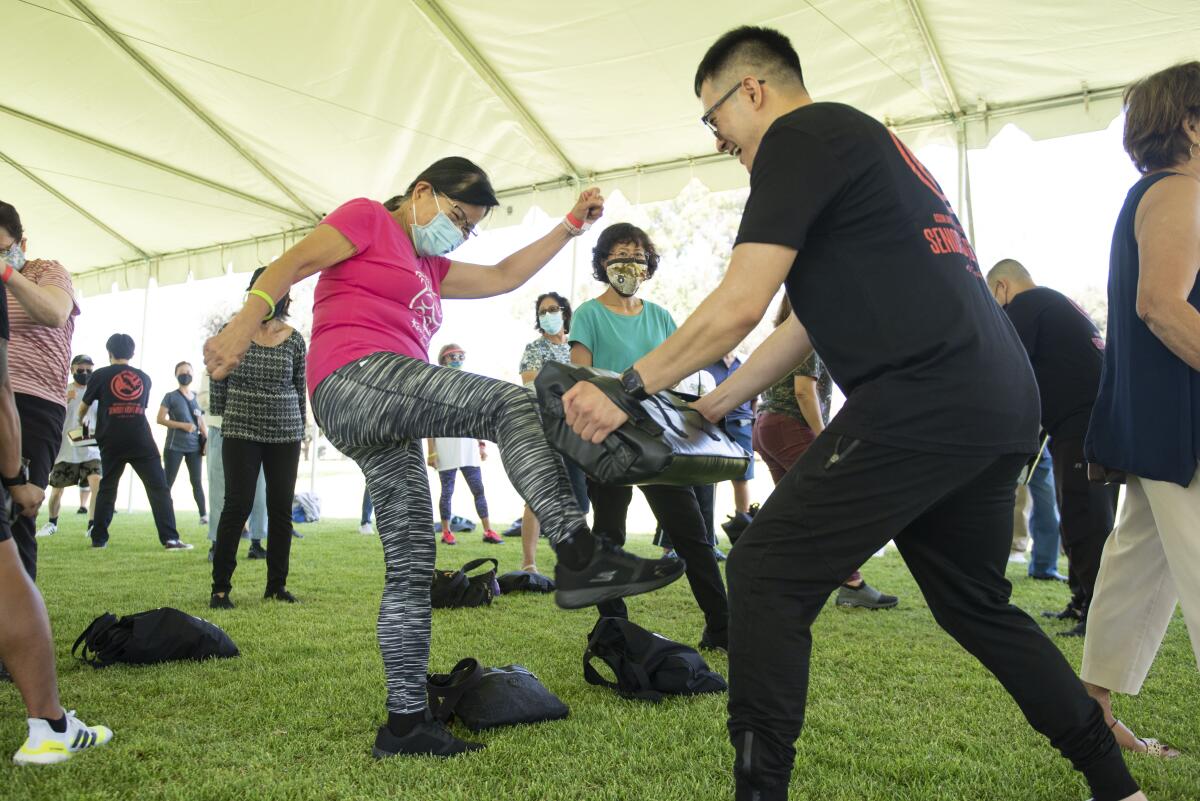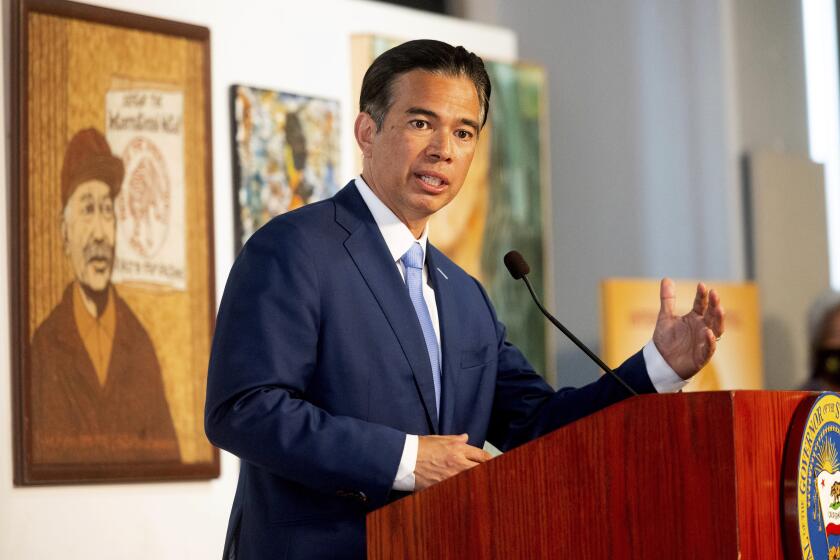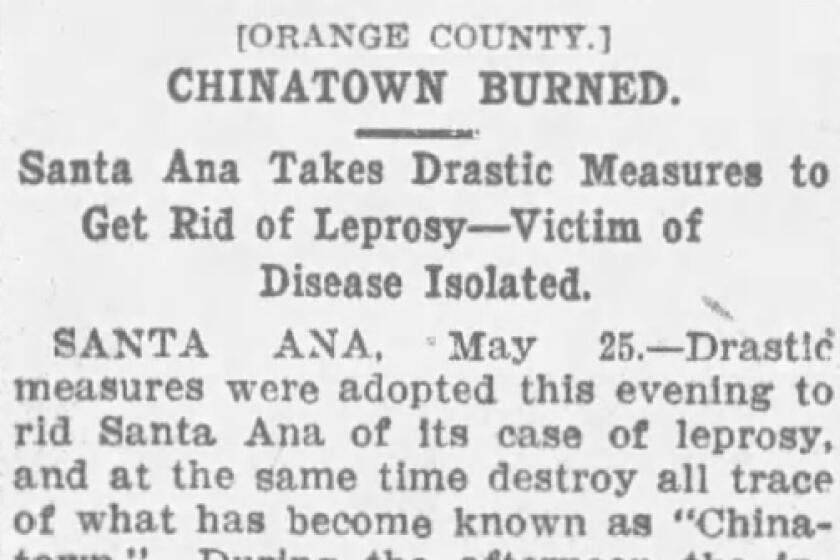Hate attacks are up in Orange County, with a huge increase against Asian Americans, new report says

- Share via
Hate crimes increased by 35% in Orange County in 2020, the largest annual jump in at least a decade, according to a new report.
Hate-motivated attacks that did not rise to the level of a crime — known as hate incidents — increased by 69%, driven largely by an 19-fold increase in attacks on Asian Americans.
The findings, released Friday by the nonprofit Orange County Human Relations Commission, mirror statewide trends.
A state attorney general’s report found that hate crimes reported to law enforcement rose 31% last year, with attacks against Asians up by 107%.
From assaults on senior citizens in the Bay Area to the shooting of six women at Atlanta-area spas, violence against Asians has surged during the pandemic.
The Orange County report cited 112 hate crimes and 263 hate incidents documented by law enforcement, education institutions, community organizations and individuals. The report also included hate crimes and incidents reported to Stop AAPI Hate, a nonprofit that began tracking anti-Asian attacks in 2020.
Researchers believe that hate attacks are likely underreported, with some victims afraid to go to authorities or unsure how to file.
Hate crimes in Orange County have been on the rise since 2015. Hate incidents, on the other hand, declined slightly in 2019 after a four-year climb, then rose sharply in 2020, according to the Human Relations Commission’s report.
“It really goes without saying that there is a lot of work to be done in our county and across the country,” said Nhi Nguyen, the hate crime prevention coordinator for the Orange County Human Relations Commission.
Black people, Latinos, Asian Americans, gay individuals and those of the Jewish faith were among the most frequently targeted in hate crimes, which can range from hate-motivated graffiti on private property to physical assaults to murder.
Although Black people constitute less than 2% of Orange County’s nearly 3.2 million residents, they were the most targeted racial group for hate crimes. There were 30 anti-Black hate crimes in 2020 compared with 16 in 2019, according to the report.
“It’s just distressing to see that year over year, the Black community in Orange County is disproportionately among the victims of hate incidents and crimes, which are a far more serious expression of hate,” said Douglas Haynes, the vice chancellor for equity, diversity and inclusion and chief diversity officer at UC Irvine.
Asian Americans were the most frequent targets of race-based hate incidents, which can consist of verbal abuse, harassment, bullying and other types of behavior that is hateful but not a crime.
The report counted 76 anti-Asian hate incidents — up by a factor of 19 — followed by 38 hate incidents against Black people and 15 against Latinos.
Racially motivated attacks against Asians have become increasingly common during the coronavirus pandemic, with some blaming Asians because of the virus’ origins in Wuhan, China.
Former President Trump fanned the flames by using terms like “China virus” and “kung flu.”
In an example of a hate incident cited in the Orange County report, a stranger yelled ,”F—ing Chinese! Coronavirus!” at an Asian family near a gas station.
“Hate crimes and hate incidents have always existed, going back to the burning of Chinatown here in Santa Ana. But now, the public is emboldened just to act up or act out, and that’s happening across different age groups, not just seniors,” said Mary Anne Foo, executive director of OCAPICA, Orange County Asian Pacific Islander Community Alliance.
Too few of us see the recent anti-Asian madness for what it is: a plague that can only end when non-Asian Americans see the blind spot within us.
Hate incidents against Asian Americans have continued to make news this year.
A Ladera Ranch family was repeatedly harassed with rocks, verbal attacks and pounding at their door over the course of several months early this year, until neighbors stepped in to help.
In April, Orange County prosecutors charged a man with a hate crime for allegedly throwing rocks at an Asian woman and her 6-year-old son as they drove in Fullerton.
That same month, Sakura Kokumai, a karate champion who represented the United States in the 2020 Olympic Games, was verbally attacked by a man while working out at Grijalva Park in Orange.
At one point in a video of the incident, the man can be heard yelling the word “Chinese.” Kokumai, who was born in Hawaii, is Japanese American.
Weeks later, an elderly Korean couple were attacked in the same park by the same man, leading to his arrest.
Anti-Asian rhetoric has also roiled the Orange County Board of Supervisors meetings. At a meeting in July, a man called Supervisor Andrew Do a communist and yelled at him to “go the f— back to Vietnam.”
“This is really the Asian community continuing to be scapegoated,” Foo said.
During the pandemic, calls to the Orange County Asian Pacific Islander Community Alliance, a Garden Grove-based nonprofit, reporting mental health issues sparked by racial trauma have jumped threefold, she said.
In hate incidents motivated by religious prejudice, members of the Jewish community were the primary targets, with 94 of 103 incidents classified as antisemitic. This marks an increase of 50 in antisemitic hate incidents, according to the report.
The report documented 12 hate crimes and 21 hate incidents motivated by the victims’ sexual orientation or identity.
“The data is sobering ... because so many communities have been and are impacted. It’s not just the individual incident that’s reported or the crime that ultimately results in a conviction — it’s the lingering effects that remain,” said Haynes of UC Irvine.
There are two contradictory narratives about Orange County, he said.
“One narrative is very much, I believe, a 21st century narrative that we are a very diverse county. ... I think that’s real evidence for progress,” he said. “And yet at the same time, what’s striking is we have a 20th century problem, the data show, in terms of antisemitism, anti-Asian, anti-Black discrimination of various forms.”
More to Read
Sign up for Essential California
The most important California stories and recommendations in your inbox every morning.
You may occasionally receive promotional content from the Los Angeles Times.














